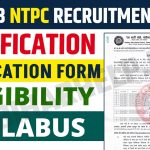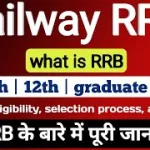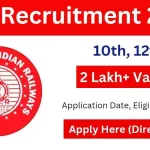The Railway Recruitment Board (RRB) Assistant Loco Pilot (ALP) & Technician exam is a gateway to a rewarding career in the Indian Railways. With thousands of aspirants vying for limited vacancies, it’s crucial to have a strategic approach to crack this competitive exam. In this comprehensive guide, we will delve into every aspect of the RRB ALP & Technician exam, including the syllabus, exam pattern, preparation strategies, and tips to excel.
Advertisements
Understanding the RRB ALP & Technician Exam
The RRB ALP & Technician exam is conducted by the Railway Recruitment Board to select candidates for the positions of Assistant Loco Pilots and Technicians across various regions of Indian Railways. The exam is divided into multiple stages, including:
- First Stage Computer Based Test (CBT-1): This stage consists of objective-type questions covering topics like Mathematics, General Intelligence and Reasoning, General Science, and General Awareness.
- Second Stage Computer Based Test (CBT-2): Candidates who qualify CBT-1 proceed to this stage, which is more specialized and covers topics related to the relevant trade.
- Computer-Based Aptitude Test (Only for ALP): Candidates applying for the Assistant Loco Pilot position need to clear this test, which assesses their aptitude for the job.
- Document Verification and Medical Examination: After clearing the above stages, candidates undergo document verification and a medical examination before final selection.
Advertisements
Syllabus Breakdown
Understanding the syllabus is the first step towards effective preparation. Here’s a breakdown of the topics covered in each section:
- Mathematics: Arithmetic, Algebra, Geometry, Trigonometry, Mensuration, Statistics.
- General Intelligence and Reasoning: Analogies, Coding-Decoding, Mathematical Operations, Syllogism, Venn Diagrams, Decision Making, Alphabetical and Number Series.
- General Science: Physics, Chemistry, Biology, Environmental Studies.
- General Awareness: Current Affairs, Indian History, Geography, Polity, Economy, Culture, Sports.
- Technical Subjects (CBT-2): Electrical Engineering, Mechanical Engineering, Electronics Engineering, Automobile Engineering, Computer Engineering.
Advertisements
Preparation Strategies
- Understand the Exam Pattern: Familiarize yourself with the exam pattern and marking scheme to strategize your preparation effectively.
- Create a Study Plan: Divide your study schedule according to the syllabus and allocate sufficient time to each topic.
- Refer to Standard Books: Utilize textbooks and reference materials recommended by experts to build a strong conceptual foundation.
- Practice Regularly: Solve previous years’ question papers and take mock tests to improve your speed and accuracy.
- Focus on Weak Areas: Identify your weak areas and work on strengthening them through consistent practice and revision.
- Stay Updated: Keep yourself updated with current affairs and developments in relevant fields to ace the General Awareness section.
- Seek Guidance: Join coaching institutes or online platforms for guidance and support from experienced mentors and peers.
Tips for Success
- Time Management: Manage your time effectively during the exam by allocating specific time limits to each section and question.
- Stay Calm and Confident: Maintain a positive attitude and stay calm during the exam. Confidence plays a crucial role in performing well.
- Avoid Guesswork: Avoid blind guessing as there is negative marking for incorrect answers. Answer only those questions you are sure about.
- Revision is Key: Revise regularly to reinforce your learning and ensure better retention of concepts.
- Healthy Lifestyle: Maintain a healthy lifestyle with proper diet, exercise, and adequate sleep to stay mentally and physically fit during the exam.
How to solve RRB ALP & Technician Exam ?
Solving the RRB ALP & Technician exam requires a strategic approach that encompasses understanding the exam pattern, mastering the syllabus, practicing regularly, and adopting effective exam-taking strategies. Here’s a step-by-step guide on how to approach and solve the RRB ALP & Technician exam:
1. Understand the Exam Pattern:
Before diving into preparation, it’s crucial to understand the exam pattern thoroughly. Familiarize yourself with the stages of the exam, the number of questions, marking scheme, and duration of each stage.
2. Know the Syllabus:
The next step is to understand the syllabus comprehensively. The RRB ALP & Technician exam covers subjects like Mathematics, General Intelligence and Reasoning, General Science, General Awareness, and Technical Subjects (for CBT-2). Make a list of topics under each subject and prioritize them based on their weightage and your proficiency level.
3. Create a Study Plan:
Develop a study plan that suits your schedule and learning style. Allocate sufficient time to cover each subject and topic thoroughly. Break down your study sessions into smaller, manageable chunks to ensure effective learning and retention.
4. Refer to Study Materials:
Gather study materials such as textbooks, reference books, online resources, and previous years’ question papers. Choose books recommended by experts and coaching institutes that cover the entire syllabus in detail. Online platforms and mobile applications also offer interactive study materials and mock tests for practice.
5. Practice Regularly:
Practice is key to success in any competitive exam. Solve a variety of practice questions, sample papers, and mock tests to gauge your preparation level and improve your speed and accuracy. Focus on solving questions from each subject and topic to ensure comprehensive coverage.
6. Focus on Weak Areas:
Identify your weak areas through practice tests and focus on improving them. Devote extra time and effort to understand the concepts, practice more questions, and seek clarification from mentors or tutors if needed. Strengthening your weak areas will boost your overall performance in the exam.
7. Time Management:
Time management is critical during the exam. Practice solving questions within the stipulated time limits to enhance your time management skills. Allocate specific time slots for each section and question, and stick to them during practice sessions.
8. Develop Exam-Taking Strategies:
During the exam, employ smart strategies to maximize your score. Start with easier questions to build confidence and momentum. Read each question carefully and prioritize answering those you are sure about. Skip difficult questions and come back to them later if time permits. Avoid spending too much time on any single question.
9. Stay Calm and Confident:
Maintain a calm and positive mindset throughout the exam. Stay focused and confident in your abilities. Don’t let anxiety or stress affect your performance. Take deep breaths, stay composed, and approach each question with a clear mind.
10. Review and Revise:
Before submitting your answer sheet, review your answers carefully. Double-check for any errors or incomplete answers. Utilize any remaining time to revise your answers and ensure accuracy. Don’t rush through the review process, but also be mindful of the time limit.
Eligibility criteria, age limit, and application process
The eligibility criteria, age limit, and application process may vary slightly based on the official notification released by the respective RRB. As of my last update, here’s some general information regarding the exam:
1. Dates: The dates for the RRB ALP & Technician Exam can vary each year. It’s best to check the official website of the respective RRB for the most up-to-date information regarding exam dates.
2. Education Eligibility:
- For Assistant Loco Pilot (ALP): Candidates should have completed Matriculation/SSLC and should possess ITI (Industrial Training Institute) certificate approved by NCVT/SCVT in relevant trades.
- For Technician: Candidates should have completed Matriculation/SSLC and should possess ITI (Industrial Training Institute) certificate in relevant trades, or should have a diploma in engineering from a recognized institution.
3. Age Limit: The age limit for the RRB ALP & Technician Exam is typically between 18 to 30 years. However, there can be age relaxations for certain categories such as SC/ST/OBC/PWD candidates as per government norms. The exact age limit and relaxations can be checked in the official notification.
4. How to Apply: The application process for the RRB ALP & Technician Exam is done online through the official website of the respective RRB. Candidates need to register on the website, fill out the application form, upload required documents such as photograph and signature, and pay the application fee as per the instructions given in the notification.
5. Selection Process: The selection process usually consists of a Computer Based Test (CBT), followed by a second stage CBT for ALP posts, and a Computer-Based Aptitude Test for ALP candidates who qualify the second stage CBT. There may also be a document verification process.
For the most accurate and updated information regarding the RRB ALP & Technician Exam, including specific details about eligibility, age limit, and how to apply, it’s recommended to regularly visit the official website of the concerned RRB or refer to the official notification released by them
Example questions and answers for RRB ALP & Technician Exam
Question: What is the function of a governor in a steam engine?
Answer: A governor in a steam engine regulates the speed of the engine by controlling the admission of steam into the cylinder. It maintains a constant speed by adjusting the steam supply based on the load variations.
Question: Define Ohm’s Law.
Answer: Ohm’s Law states that the current passing through a conductor between two points is directly proportional to the voltage across the two points, provided the temperature remains constant. Mathematically, it can be expressed as I = V/R, where I is the current, V is the voltage, and R is the resistance.
Question: What is the function of a transistor?
Answer: A transistor is a semiconductor device used primarily for amplification and switching electronic signals and electrical power. It acts as a current or voltage controlled switch or amplifier.
Question: Explain the working principle of an alternator.
Answer: An alternator works on the principle of electromagnetic induction. When a conductor is rotated within a magnetic field, it produces an alternating current (AC) output. This alternating current is then converted into direct current (DC) using a rectifier for practical applications.
Question: What are the safety precautions to be taken while working on electrical systems?
Answer: Some safety precautions include: wearing insulated gloves and shoes, using insulated tools, ensuring the power is switched off before working on circuits, properly grounding equipment, avoiding working alone, and following proper lockout/tagout procedures.
Question: What is the role of a diode in a circuit?
Answer: A diode is a semiconductor device that allows current to flow in one direction only. It is commonly used to convert AC to DC, as a rectifier, and to protect circuits from reverse current flow.
Question: Describe the function of a capacitor. Answer: A capacitor stores electrical energy in an electric field. It can release this stored energy when needed, acting as a temporary energy storage device. Capacitors are used in filtering, smoothing voltage fluctuations, and in timing circuits.
Question: Explain the working of a four-stroke internal combustion engine. Answer: In a four-stroke engine, the four strokes include intake, compression, power, and exhaust. During the intake stroke, the fuel-air mixture is drawn into the cylinder. In the compression stroke, the mixture is compressed. The power stroke is where combustion occurs, driving the piston downward. Finally, the exhaust stroke expels the burnt gases from the cylinder.
Latest Posts
- Step-by-step guide to download and apply for jee mains admit card 202
- Comprehensive 2025 government holidays and recruitment details for job seekers
- JEE Mains Admit Card 2025: Your Step-by-Step Guide to Downloading the Hall Ticket
- Everything You Need to Know About 2025 Government Holidays Recruitment
- Comprehensive Guide to rrb d group recruitment 2025 – Eligibility, Vacancies, and Application
- Detailed guide to nps trust recruitment 2025 vacancies, eligibility and apply process
- Comprehensive guide to hpcl recruitment 2025 notification, vacancies, and application process
- ignou bed admission 2025 complete recruitment guide with eligibility and process
- Comprehensive Guide to Indian Army Agniveer Recruitment 2025 Notification and Jobs
- Everything You Must Know About CBSE Board Exams 2025 Changes & New Rules




